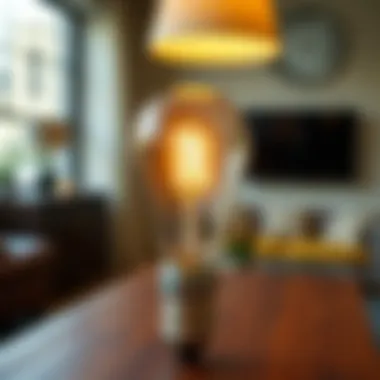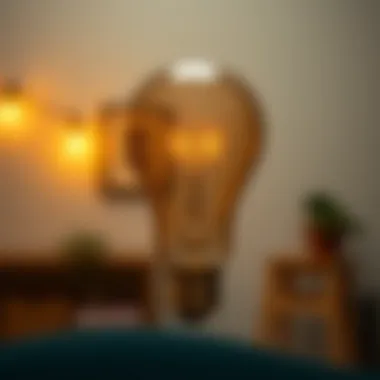Comprehensive Guide to Type T 150 Watt Bulb


Intro
When it comes to lighting, the Type T 150 Watt bulb stands out as a notable option that blends functionality and style. With advancements in design and technology, this bulb has found its way into various settings, making it a consideration not just for homeowners but also for professional designers and retailers. As we immerse ourselves in the world of lighting solutions, understanding the characteristics and applications of such bulbs is essential. This detailed guide aims to unravel the complexities of the Type T 150 Watt bulb, offering valuable insights that can enhance any environment, be it a cozy living room or a bustling retail space.
Design Trends
Current Trends in Lighting Styles
Lighting plays a pivotal role in shaping the ambiance of a room. The latest trends in lighting emphasize versatility and creativity, with the Type T 150 Watt bulb leading the way in several key aspects:
- Vintage Aesthetics: Many homeowners are leaning towards bulbs that echo a retro feeling. The Type T bulb, with its distinctive shape, fits beautifully in vintage-style fixtures.
- Eco-Friendly Options: As the push for sustainability grows, energy-efficient lighting solutions are particularly appealing. The Type T 150 Watt bulb often provides the necessary lumens while remaining eco-conscious.
- Statement Lighting: Designers are increasingly incorporating bold light fixtures to create unique focal points. This bulb can be featured in elaborate chandeliers or simple pendant lights, making it adaptable to your style.
How to Incorporate Lighting Trends into Your Space
Transforming a space with lighting can be both an art and a science. Here are a few tips for incorporating the Type T 150 Watt bulb into your design:
- Layer Lighting: Mix different types of lighting—ambient, task, and accent lighting—to create depth. Use Type T bulbs in lamps and overhead fixtures to achieve balance.
- Play with Placement: Experiment with heights and configurations. Placing the bulbs at different heights can craft intriguing shadows and highlights.
- Combine Materials: Whether it's glass, metal, or wood, the Type T bulb complements different materials. Pair it with brass for a luxe feel or use it in minimalist fixtures for a sleek appearance.
- Choose the Right Color Temperature: Select bulbs with warm temperatures for cozy settings and cooler temperatures for workspaces. This tiny detail can drastically change the mood of any room.
"In the world of design, light is not just a source of illumination; it’s a tool for creating mood and atmosphere."
Buying Guides
Choosing the Right Bulb for Different Rooms
Understanding where and how to use the Type T 150 Watt bulb can maximize its benefits in your home. Here’s a brief look into various applications:
- Living Rooms: Opt for bulbs with warm white tones to create a welcoming environment. Utilize them in floor lamps or wall sconces.
- Kitchens: Bright, cool-toned bulbs are ideal for task areas. Type T bulbs can be added to pendant lights above countertops.
- Bedrooms: Consider dimmable versions to adjust the light according to the time of day or activity. Warm hues can promote relaxation.
- Outdoor Spaces: With the right fixtures, Type T bulbs can safely illuminate patios or gardens, enhancing outdoor gatherings.
Tips for Assessing Quality and Value
When selecting Type T bulbs, it helps to keep a few quality markers in mind:
- Lifespan: Check the manufacturer's specifications for an expected lifespan. The more hours rated, the better the value behind your purchase.
- Energy Efficiency: Look for bulbs that provide a high lumen output per watt to save on electricity bills.
- Warranty: A product backed by a warranty often signifies quality craftsmanship.
Each aspect plays into maximizing the effectiveness and efficiency of lighting in any room. By paying attention to these elements, you can ensure that your lighting solutions enhance both the aesthetics and functionality of your spaces.
For more insights into the benefits of different types of bulbs, consider resources like Wikipedia or industry blogs on Reddit.
By understanding the intricate details of the Type T 150 Watt bulb, you can make informed lighting choices that positively impact your surroundings.
Preamble to Lighting Technologies
Lighting technologies encompass a variety of systems that illuminate our spaces, and their significance cannot be overstated. In the world of design, proper illumination can transform an environment, influencing mood, productivity, and even the overall aesthetic of a room. Understanding the different types of lighting solutions available is crucial for homeowners, designers, and anyone else seeking to enhance the livability of a space.
Overview of Light Bulb Types
Light bulbs come in numerous shapes and sizes, each characterized by unique features tailored to specific functional and aesthetic needs. Common types include incandescent, CFL (compact fluorescent), LED (light-emitting diode), and halogen bulbs.
- Incandescent Bulbs: Often seen as the traditional choice, they provide warm light but are less energy-efficient.
- CFL Bulbs: These consume less energy than incandescents but may produce a harsher light.
- LED Bulbs: Known for their energy efficiency and longevity, LEDs are quickly becoming the go-to option due to their versatility.
- Halogen Bulbs: These provide bright and white light, making them suitable for highlighting artwork but tend to run hotter.
Each type has its pros and cons, so selecting the right bulb type requires consideration of the intended application, energy needs, and desired ambiance. As we delve deeper into specific products like the Type T 150 Watt bulb, it's crucial to understand the contexts in which these technologies best serve their purpose.
What is a Type T Bulb?
A Type T bulb, often referred to as a tubular bulb, is distinguished by its elongated shape. Unlike traditional bulb designs, the Type T allows for even light distribution, making it suitable for a variety of applications.
The designation "T" corresponds to the diameter of the bulb in eighths of an inch; for instance, a Type T bulb measuring 150 watts will typically have a compact, slender profile ideal for decorative fixtures or settings requiring focused lighting.
These bulbs are particularly favored in commercial spaces and for specific residential uses. Their design not only serves an aesthetic function but also enhances functionality by providing a broad illumination area without overwhelming glare.
In summary, the exploration of lighting technologies, including various types of bulbs and specifically the Type T bulb, sets the stage for understanding the intricacies involved in choosing the right lighting solutions. The right bulb can make all the difference, whether you’re revamping a cozy living room or designing a corporate office environment.
Technical Specifications of the Type T Watt Bulb
Understanding the technical specifications of the Type T 150 Watt bulb is critical for anyone looking to make informed choices about their lighting solutions. This section highlights the specific elements that define this bulb’s performance, benefits, and potential drawbacks. The specifications offered here can serve as a guide for homeowners, designers, retailers, and DIY enthusiasts who aim to select the ideal lighting solution for their needs.
Wattage and Lumens
Wattage in bulbs has long been a straightforward indicator of how much energy consumption one might expect. The Type T 150 Watt bulb, classified by its power consumption, means it utilizes 150 watts of electrical energy. However, it’s not merely about what’s being consumed; it also speaks volumes about luminous output. The lumens produced can vary significantly depending on the technology behind the bulb.
For example, a 150 Watt incandescent bulb produces around 2,600 lumens, providing a warm and inviting atmosphere typical of traditional lighting. In contrast, newer technologies like compact fluorescents or LEDs achieve similar lumens using much less wattage. If a homeowner is on the lookout for a greener option, opting for an LED comparable to the Type T can ensure a significant drop in energy use.
Base Types and Compatibility


The base type of a bulb is often an overlooked element that can vastly impact usability and installation. The Type T 150 Watt bulb typically comes with a standard base, often classified as E26, which is compatible with most household fixtures. However, some variations might exist based on specific designs or manufacturer standards.
When considering compatibility, the following should be noted:
- E26 Base - Generally used in most residential fixtures.
- Specialty Bases - Some designs might have a different base type, which may necessitate adapters or entirely different fixtures.
Before purchasing, it's good practice to double-check the base type, ensuring that the bulb will fit seamlessly into existing fixtures, avoiding any headache during installation.
Lifespan and Durability
Life expectancy of lighting products is paramount. The Type T 150 Watt bulb’s lifespan can fluctuate substantially between different technologies. Traditional incandescent variants of this bulb may last around 1,000 hours, offering a decent but limited lifespan. In contrast, compact fluorescent and LED options can outshine their counterparts by lasting up to 10,000 to 25,000 hours.
Factors that influence lifespan include:
- Operating Conditions: Frequent on/off cycling can shorten the life of incandescent bulbs.
- Heat Generation: Higher temperatures can lead to premature bulb failure.
In general, if durability and longevity are key concerns, moving towards dimmable LEDs or fluorescent designs can present a wise investment. The upfront cost may be higher, but reduced frequency of replacement and lower electricity bills make a solid case for the transition.
"Choosing the right bulb isn't just about brightness. It's about understanding how it fits into your lifestyle and space."
In summary, the technical specifications of the Type T 150 Watt bulb matter deeply. By examining wattage, lumens, base compatibility, and durability, individuals can enhance not just their lighting but their overall living or working experience.
Energy Efficiency Considerations
In the realm of lighting technologies, energy efficiency holds significant weight. This is particularly true for the Type T 150 Watt bulb. As society grows increasingly aware of environmental implications and rising energy costs, consumers and businesses are scrutinizing their energy consumption more than ever. Understanding energy efficiency not only contributes to lower electricity bills but also aligns with broader sustainability goals. The Type T bulb offers both effective illumination and a path toward more responsible energy use.
Comparison with Other Bulb Types
When diving into comparisons, it’s essential to recognize that not all light bulbs are created equal. The Type T 150 Watt bulb stands in stark contrast to traditional incandescent bulbs, which consume more energy for the same illumination level.
- Incandescent Bulbs: Generally, these bulbs use about 60-100 watts for similar light output, resulting in higher energy use over time.
- Compact Fluorescent Lamps (CFLs): These consume approximately 13-15 watts for equivalent brightness but have a shorter lifespan compared to Type T bulbs.
- Light Emitting Diodes (LEDs): While LEDs are at the forefront of energy efficiency, the Type T bulb can still outsmart them in specific applications requiring high wattage output.
While the Type T bulb may seem like an energy hog at 150 watts, it serves a niche that often demands high brightness without the flicker characteristic of some other bulb types.
"Energy efficiency is not just a trend; it's a necessity for sustainable living."
Impact on Electricity Bills
The financial implications of switching to a Type T 150 Watt bulb cannot be understated. For households and businesses alike, every watt counts. Let’s break down how this bulb impacts energy bills:
- High initial wattage leads to immediate increases in electricity costs. However, when used appropriately in environments that require significant brightness, it can actually lead to greater satisfaction that encourages prolonged use.
- Comparatively, lower-wattage options may seem appealing but might necessitate frequent replacements or additional fixtures to achieve desired illumination levels.
Homeowners and businesses must weigh their options carefully. A comparison of projected monthly energy expenses between the Type T and other bulb types can aid in making an informed choice. Here’s a high-level overview:
| Bulb Type | Average Daily Use (Hours) | Wattage | Estimated Monthly Cost | | Type T | 5 | 150 | $22.50 | | Incandescent| 5 | 100 | $15.00 | | CFL | 5 | 15 | $2.25 | | LED | 5 | 10 | $1.50 |
In summary, despite a higher wattage, the Type T bulb remains relevant—especially in settings that demand robust lighting solutions—where energy efficiency concerns are met with effective light output.
Applications of the Type T Watt Bulb
The application of the Type T 150 Watt bulb is a vital aspect of its overall significance and utility in both residential and commercial spaces. Understanding where and how these bulbs can be effectively deployed allows homeowners, designers, and businesses to optimize their lighting choices. The Type T bulb serves a variety of purposes, from enhancing aesthetic appeal to providing essential lighting in functional spaces. Let’s delve into the specifics of how these bulbs can be applied in various settings, showcasing their versatility and practicality.
Residential Uses
When it comes to home environments, the Type T 150 Watt bulb shines bright.
- Living Spaces: In areas like living rooms and dens, these bulbs create a warm and inviting atmosphere. Their high wattage ensures ample light for activities like reading or entertaining.
- Kitchens: The kitchen is often seen as the heart of a home. A Type T bulb can illuminate countertops effectively, making food preparation a breeze. Installing them under cabinets can provide direct lighting that enhances visibility and safety while cooking.
- Outdoor Areas: For patios or balconies, using Type T bulbs can extend the usability of outdoor spaces into the night. Their brightness can help create a cozy environment for evening gatherings.
Such applications not only cater to practical needs but also enhance the aesthetic feel of a home. Homeowners can enjoy a blend of purpose and style by utilizing Type T bulbs in unique fixtures.
Commercial Settings
In the bustling world of commercial enterprises, the role of the Type T 150 Watt bulb is equally crucial. These bulbs contribute significantly to workplace efficiency and customer experiences:
- Retail Stores: Bright and welcoming lighting is essential for retail spaces. Type T bulbs can highlight products effectively, drawing attention to merchandise. A well-lit store can lead to increased sales as customers feel more attracted to actively engaging with products.
- Restaurants: The ambiance of a restaurant can make or break a dining experience. Type T bulbs offer versatility in adjusting lighting to suit various moods—from casual dining to formal events, they can help set the right tone. It also makes the food look more appetizing, enhancing the overall dining experience.
- Warehouses or Industrial Use: In environments that require functional lighting for safety, Type T bulbs provide enough brightness to minimize shadows. This is crucial in areas where machinery operates or where employees handle products needing careful attention.
Commercial applications show that the right lighting significantly impacts both functionality and customers' perception of a brand.
Specialty Uses
Apart from standard residential and commercial settings, the Type T 150 Watt bulb finds its way into various specialty applications:


- Photography and Art Studios: For artists and photographers, lighting can spell the difference between a good shot and a great one. Type T bulbs offer a brightness that captures colors authentically, making them a preferred choice in studios for high-quality work.
- Theatrical Lighting: In live performances, lighting plays a critical role in setting the mood. Type T bulbs can facilitate dynamic lighting setups, enhancing production values for plays and concerts.
- Event Lighting: The versatility of Type T bulbs allows them to be utilized in a range of events from weddings to corporate gatherings. They can be integrated into decorative fixtures that complement themes while ensuring ample light.
The applications of the Type T 150 Watt bulb demonstrate its adaptability across diverse contexts. By understanding these uses, consumers can make the most informed choices, enhancing both functionality and aesthetic appeal while investing in quality lighting.
Design Implications of Lighting
Lighting plays a pivotal role in the overall aesthetics and functionality of a space. The Type T 150 Watt bulb, known for its high output and versatility, carries significant design implications that extend beyond mere illumination. Understanding how this bulb affects design choices is crucial for homeowners, designers, and enthusiasts alike. By carefully considering both the aesthetic and psychological impact of lighting, one can create spaces that are not only well-lit but also visually appealing and conducive to the desired mood.
The implications of lighting design can fundamentally influence perception and experience within a space. It's well-known that a well-lit environment can enhance productivity and mood, while inadequate lighting can cause strain and discomfort. For those looking to integrate the Type T 150 Watt bulb into their spaces, grasping these design implications can lead to more informed choices that elevate their environments.
Aesthetic Considerations
When selecting lighting, the aesthetic quality often falls into the spotlight—quite literally. The Type T 150 Watt bulb boasts not just brightness but also a warm color temperature, lending an inviting glow to interiors. This warmth can transform an ordinary room into a cozy retreat, evoking feelings of comfort and relaxation.
The bulb's clear glass design allows it to integrate seamlessly into a variety of fixtures, from pendant lights to floor lamps. Here are a few aesthetic elements to consider when working with this type of bulb:
- Fixture Compatibility: Type T bulbs work effectively in various fixtures, enhancing their aesthetic appeal without overwhelming the design. Choosing the right fixture can create a focal point that draws the eye.
- Color Temperature: Opting for a bulb with a warmer hue allows for a softer ambiance, which can be inviting. Counter to this, cooler temperatures can create a sharper, more modern feel.
- Brightness Levels: The Type T's high wattage means it serves well in spaces with high ceilings or large areas. Thoughtful placement can highlight architectural features or artwork, elevating the room's visual appeal.
The right light can bring out the best in a room, turning a dull space into a vibrant experience.
Creating Mood and Ambiance
Lighting is not just functional; it is a crucial player in setting the mood and ambiance. The Type T 150 Watt bulb's brightness allows for flexibility depending on the time of day and the activities occurring within the space.
Here’s how this bulb can help craft the right atmosphere:
- Layering Light: Combining Type T bulbs with dimmers can create adaptable lighting scenarios. Whether hosting a dinner party or enjoying a quiet night, adjusting brightness levels can cater to different moods effortlessly.
- Highlighting Areas: Using the Type T bulb in accent lighting—like wall sconces or display cases—can draw attention to art or specific features while keeping the overall lighting soft and inviting.
- Practical vs. Decorative: Understanding when to use the bulb for practical purposes and when to opt for softer, decorative lighting can guide homeowners towards creating spaces that feel thought-out and pleasing.
The interplay between brightness, color, and placement will ultimately dictate the ambiance of any given room. Keeping these factors in mind can allow for personalized spaces that reflect the tastes and needs of those who inhabit them.
Installation and Maintenance
Importance of Installation and Maintenance
When it comes to any lighting solution, the ways we put them in place and keep them running smoothly can make all the difference. For the Type T 150 Watt bulb, understanding its installation and maintenance is crucial for a number of reasons. Proper installation ensures not only the longevity of the bulb but also its efficiency and safety in usage. In short, if you want to avoid any future hiccups down the road, a careful approach from the get-go is a real game-changer.
Moreover, maintenance plays an equally vital role. Regular checks and care can enhance performance, making sure that every watt provides its best value. Additionally, maintaining a Type T bulb can help in avoiding unnecessary costs in replacements and repairs that arise from neglect. Therefore, having a solid grasp of installation principles and maintenance practices is advantageous not just for homeowners, but also for designers and professionals who aim to guide their clients accordingly.
Installation Guidelines for Type T Bulbs
The correct installation of a Type T 150 Watt bulb will ensure it lights up your space effectively. Here are some key guidelines:
- Turn Off Power: Before replacing any bulb, ensure that the power is switched off. It might seem like a no-brainer, but safety first!
- Select the Right Base: The Type T bulb has specific base requirements. Check if your fixture has the correct base type—commonly, this will be the medium Edison base. Use only compatible fixtures.
- Handle with Care: When installing, be mindful of the bulb's glass. Avoid applying excessive pressure, as this could lead to breakage.
- Secure Fit: When screwing in the bulb, do not overtighten as it can damage both the bulb and the fixture. A snug fit is sufficient to ensure it functions properly.
- Check for Flickering: After installation, turn on the power and observe the bulb for any flickers. If you notice any, this might indicate a loose connection or an incompatible fixture.
Maintenance Tips and Best Practices
Keeping a Type T 150 Watt bulb in optimum condition requires some thoughtful upkeep. Here are a few best practices:
- Regular Cleaning: Dust can accumulate on the bulb surface, dimming its light output. Use a soft, dry cloth to gently wipe it clean, ensuring it's turned off and cool to the touch.
- Monitor Performance: Keep an eye out for any changes in brightness. Dimming may suggest that the bulb is nearing the end of its lifespan, whereas an abrupt flickering could point to electrical issues.
- Check Socket Connection: If you find that your bulb is flickering, check the socket connection. Loose connections can affect performance and pose safety risks.
- Use Surge Protectors: To prolong the lifespan against power surges, consider using surge protectors. This is especially valuable in areas prone to electrical storms or unstable voltage.
Remember, maintaining your Type T bulb well not only maximizes its longevity but also saves you from pesky replacement hassles.
Having a handle on these installation and maintenance aspects can empower users to make the most out of their Type T 150 Watt bulbs, ensuring that every light they put up shines just the way they envisioned.
Troubleshooting Common Issues
Lighting directly affects our environments, whether at home, at work, or anywhere else. It's crucial to be able to quickly sort out any issues that arise with lighting fixtures like the Type T 150 Watt bulb. Tackling problems not only eases the user experience but also extends the life and effectiveness of the lighting. Understanding and resolving these common candle dilemmas keeps your spaces bright and functional.
Dim Lighting Problems
Ever flip the switch only to be greeted by a dim glow? This can be frustrating. Dim lighting issues often arise from a few culprits, which include:
- Faulty Connections: Loose fittings can hinder electricity flow. Tighten the bulb into the socket properly. Check for any corrosion on the base; a little scrubbing could go a long way.
- Incompatible Dimmer Switch: If you’re using a dimmer switch that isn’t compatible with Type T 150 Watt bulbs, problems will crop up. Switching to a compatible dimmer can solve these woes.
- Voltage Fluctuations: Unstable voltage can lead to underperformance. Consider calling in an electrician who can check the circuit.
- Older Bulbs: Age is a factor; as bulbs wear out, light output diminishes. If your Type T bulb has seen better days, perhaps it’s time for a replacement.
Using higher quality fixtures can make a marked difference. Choosing reputable brands not only feels good but also ensures lasting results. Remember — if one bulb dims, it might be time to inspect the entire bunch.
Flickering and Blinking
Flickering can be like that annoying itch you can't scratch. It disrupts not just your concentration; it can also signify bigger issues that need to be addressed. Here’s what to look for:
- Bulb Seating: Ensure the bulb's connection is snug. A loose bulb may cause flickering due to poor contact in the socket.
- Wiring Problems: Frayed or damaged wiring could lead to inconsistent power, causing lights to dance. If it's within reach, taking a look can help. If things seem complex, seeking professional help is advisable.
- Power Supply Interference: Sometimes, devices plugged into the same circuit can affect bulb performance. Check if other electronics are causing these hiccups.
- Overheating: Type T bulbs shouldn't be stuffed into narrow fixtures without ventilation. Too much heat can lead to flickering and even permanent damage. Make sure there's proper airflow around the bulb.


When troubleshooting flickering issues, it helps to have a test bulb on hand to rule out whether it's the bulb itself or a wiring issue. A little methodical check here and there can save you not only headaches but also cash in the long run.
Lighting isn’t just about visibility; it provides comfort and creates ambiance. Addressing issues head-on preserves these essential aspects of our daily lives.
Regulatory Considerations
Understanding the regulatory landscape surrounding the Type T 150 Watt bulb is essential. Compliance with various standards ensures not just that users get a safe and efficient product, but also that the broader environmental impact is considered. This section will delineate the key aspects of certification standards and environmental regulations that relate to lighting technologies, particularly the Type T 150 Watt bulb.
Certification Standards
Certification standards play a critical role in establishing the safety and efficacy of the Type T 150 Watt bulb. Numerous organizations, such as Underwriters Laboratories (UL) and the International Electrotechnical Commission (IEC), set guidelines that manufacturers must follow.
- Safety Testing: These standards ensure that bulbs do not pose a fire hazard or risk electrical shock. For example, UL tests bulbs for durability responses, like how they withstand heat and electrical surges.
- Performance Metrics: Certification also covers luminous efficacy—how well a bulb converts electricity into visible light. A bulb with a higher efficacy is more desirable since it produces more lumens per watt, leading to energy savings over time.
- Consumer Trust: Products that bear recognized certification marks are often favored in the marketplace. People tend to gravitate toward known entities that demonstrate accountability regarding quality and safety, thereby influencing their purchasing decisions.
Environmental Regulations
Environmental regulations increasingly govern how lighting products like the Type T 150 Watt bulb are manufactured and disposed of. These regulations are vital for a greener future and encourage companies to adopt more sustainable practices.
- Material Guidelines: An important aspect involves limiting hazardous substances in bulb production, such as lead and mercury. The Restriction of Hazardous Substances (RoHS) directive is one such regulation that mandates manufacturers to take action against the use of toxic materials.
- End-of-Life Management: Regulations often stipulate how to handle bulbs at their end of life to minimize negative effects on the environment. For example, many places now require consumers to recycle energy-efficient lighting solutions, preventing them from ending up in landfills where they could leach harmful substances into the soil.
- Energy Consumption Standards: The energy efficiency of lighting products falls under regulations too. Agencies like the Department of Energy (DOE) enforce minimum energy performance standards that help in reducing overall electricity consumption.
Understanding these regulations isn't just about compliance; it's about contributing to a sustainable future and ensuring safety in our everyday environment.
By being aware of such standards and regulations, homeowners, designers, and retailers can select Type T 150 Watt bulbs with confidence, knowing that they meet both safety and environmental criteria.
Market Trends and Future Developments
In the ever-evolving landscape of lighting solutions, the Type T 150 Watt bulb finds itself at a critical juncture. Understanding the market trends and future developments surrounding this bulb is essential not only for consumers but also for designers, retailers, and DIY enthusiasts. As we delve into this topic, we'll highlight how shifts in technology and consumer preferences shape the lighting market and discuss the broader implications of these changes.
The Shift Toward LED Technologies
The move towards LED technologies has been nothing short of revolutionary. With their energy efficiency, longevity, and relatively low environmental impact, LEDs have carved a niche that is hard to ignore. Energy savings is one of the primary drivers.
- LEDs often consume 75% less energy than conventional bulbs, which means a significant reduction in energy bills over time.
- The longevity of an LED bulb can reach up to 25,000 hours, far outpacing traditional incandescent and fluorescent lighting.
While the Type T 150 Watt bulb predominantly reflects older technologies, there's an ongoing dialogue about how this bulb type can adapt and integrate LED options. It's a viable choice for similar applications, like high-wattage lighting for both residential and commercial spaces.
This transition has begun to influence designs. As homeowners and designers increasingly prioritize sustainability and cost-effectiveness, manufacturers are responding by innovating bulbs that are not just functional but visually appealing as well. It’s like watching a chef create a fusion dish—combining the strengths of classic and modern elements.
Innovations in Bulb Design
The world of bulb design has witnessed dramatic changes, and the current trend leans heavily into innovation and sustainability. From smart bulbs that can be controlled via smartphone apps to designs that offer enhanced aesthetic flexibility, innovation keeps the market vibrant.
- Smart Lighting: Many new bulbs now come with smart capabilities, allowing users to adjust brightness, color temperature, and even create schedules—all while being energy-efficient.
- Custom Shapes and Styles: Manufacturers are breaking away from the traditional bulb shapes, creating pendants, globes, and even artistic fixtures that serve both functional and decorative purposes.
- Eco-Friendly Materials: New materials used in bulb production not only aim to reduce waste but also enhance the overall design aesthetics while being more comfortable for both the eye and the environment.
"Creative designs can be just as important as functionality when it comes to lighting solutions. Reflecting a space's personality might even trump energy savings in certain ‘style-centric’ markets."
As we witness these innovations, the Type T 150 Watt bulb is also gradually being reimagined to align with modern expectations, blending retro functionality with cutting-edge design. Awareness of these trends can empower consumers to choose lighting solutions that are both practical and aligned with their personal style, contributing to a space that feels uniquely theirs.
In summary, the shifts in lighting technology and design represent more than just market trends; they are indicative of broader changes in consumer ideology, emphasizing responsibility toward energy use, aesthetic value, and a touch of personalization. Keep these insights in mind when considering the T 150 Watt bulb and its potential role in your lighting strategy.
Epilogue and Recommendations
When discussing the Type T 150 Watt bulb, it becomes clear that its impact is felt across various sectors, from residential applications to commercial environments. Understanding this particular type of bulb not only equips users with knowledge about lighting choices but also fosters a greater appreciation for the role lighting plays in design and functionality.
One significant aspect to consider is the bulb’s efficiency. With its relatively high lumens output at 150 watts, it serves as a powerful source of light for larger spaces. However, consumers must weigh the benefits of brightness against potential energy costs. This bulb can be an asset in places where strong illumination is necessary, such as workshops or large family areas.
Also, the compatibility with different fixtures and systems is crucial. Homeowners should ensure that their chosen lighting elements can accommodate Type T bulbs. This might mean checking the base type or assessing the fixture's environment, especially in areas subject to moisture or heat. Furthermore, considering the lifespan of the bulb is essential. Choosing products that last longer can save both time and money in replacements.
In sum, the recommendations for the Type T 150 Watt bulb lean toward its strategic use. Place it where bright, reliable lighting is essential. These bulbs can significantly enhance the functionality of spaces and add to the overall aesthetic when paired correctly with other design elements.
Final Thoughts on the Type T Watt Bulb
The Type T 150 Watt bulb stands out in the crowded market of lighting solutions. Its robust performance makes it a prime candidate for high-output requirements, be it in residential or commercial applications. However, being aware of its energy demands and ensuring compatibility with existing systems is crucial for optimal satisfaction.
Additionally, although LED technologies are on the rise, the Type T still holds its own in circumstances where traditional lighting methods are preferred. This is especially true in historical restorations or settings where the preservation of warmth in light color is essential.
As lighting technology continues to evolve, balancing efficiency with traditional lighting's qualities remains central to decision-making. Therefore, those considering the Type T 150 Watt bulb should remain informed and weigh their options accordingly.
Guidelines for Choosing the Right Bulb
Choosing the right lighting for a specific setting goes beyond mere luminosity. Here are some guidelines to consider:
- Assess Your Needs: Determine the kind of ambiance or functionality required in the space. Bright light, like that offered by a Type T bulb, works well in workspaces but might be too harsh for intimate settings like dining areas.
- Check Compatibility: Ensure the bulb will fit into your existing fixtures. The base type of the Type T needs to match what you have at home or in your workplace.
- Evaluate Energy Costs: Understand how much energy the bulb will consume over its lifespan. The initial cost is just one part of the total expense, factoring in electricity usage is also vital.
Make informed decisions that suit your needs while maintaining an eye on efficiency.
- Lifespan and Maintenance: Consider how often you would want to replace bulbs. Choose bulbs that provide longevity to minimize maintenance.
- Explore Options: Lastly, don’t shy away from comparing the Type T against other bulb types like LEDs. Sometimes, exploring newer technology can lead to better savings and experiences.
By following these guidelines, selecting the right bulb can become a straightforward and effective process, providing the best lighting solutions tailored to your specific environment.















